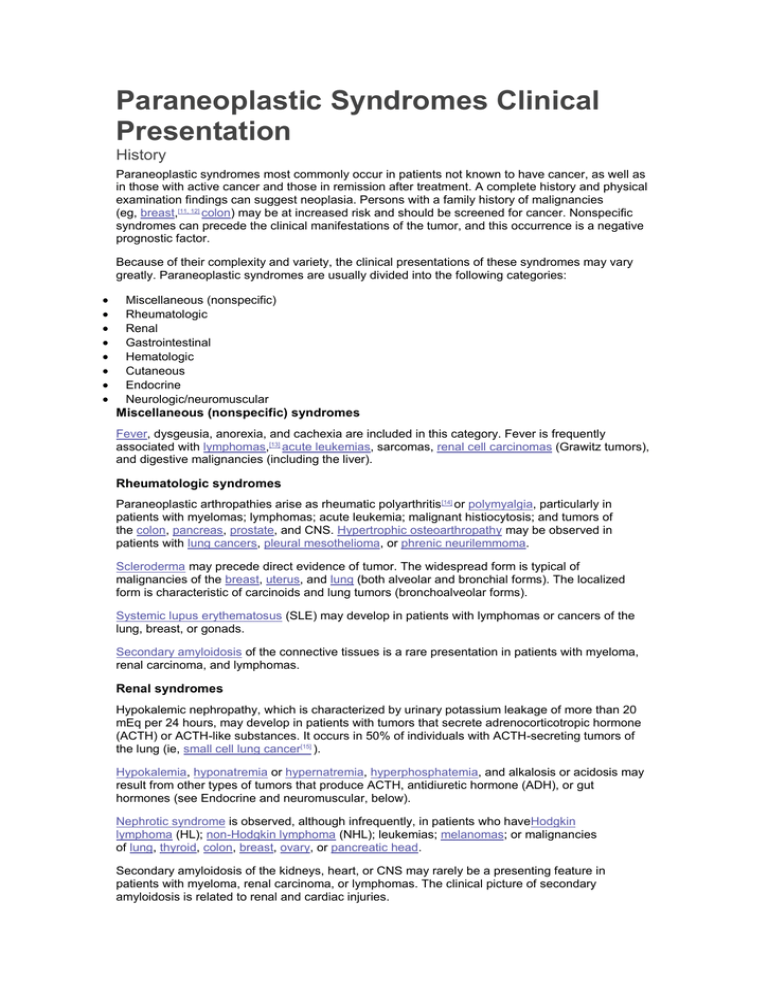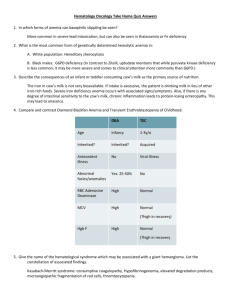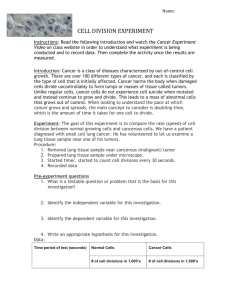Paraneoplastic Syndromes Clinical Presentation History
advertisement

Paraneoplastic Syndromes Clinical Presentation History Paraneoplastic syndromes most commonly occur in patients not known to have cancer, as well as in those with active cancer and those in remission after treatment. A complete history and physical examination findings can suggest neoplasia. Persons with a family history of malignancies (eg, breast,[11, 12] colon) may be at increased risk and should be screened for cancer. Nonspecific syndromes can precede the clinical manifestations of the tumor, and this occurrence is a negative prognostic factor. Because of their complexity and variety, the clinical presentations of these syndromes may vary greatly. Paraneoplastic syndromes are usually divided into the following categories: Miscellaneous (nonspecific) Rheumatologic Renal Gastrointestinal Hematologic Cutaneous Endocrine Neurologic/neuromuscular Miscellaneous (nonspecific) syndromes Fever, dysgeusia, anorexia, and cachexia are included in this category. Fever is frequently associated with lymphomas,[13] acute leukemias, sarcomas, renal cell carcinomas (Grawitz tumors), and digestive malignancies (including the liver). Rheumatologic syndromes Paraneoplastic arthropathies arise as rheumatic polyarthritis[14] or polymyalgia, particularly in patients with myelomas; lymphomas; acute leukemia; malignant histiocytosis; and tumors of the colon, pancreas, prostate, and CNS. Hypertrophic osteoarthropathy may be observed in patients with lung cancers, pleural mesothelioma, or phrenic neurilemmoma. Scleroderma may precede direct evidence of tumor. The widespread form is typical of malignancies of the breast, uterus, and lung (both alveolar and bronchial forms). The localized form is characteristic of carcinoids and lung tumors (bronchoalveolar forms). Systemic lupus erythematosus (SLE) may develop in patients with lymphomas or cancers of the lung, breast, or gonads. Secondary amyloidosis of the connective tissues is a rare presentation in patients with myeloma, renal carcinoma, and lymphomas. Renal syndromes Hypokalemic nephropathy, which is characterized by urinary potassium leakage of more than 20 mEq per 24 hours, may develop in patients with tumors that secrete adrenocorticotropic hormone (ACTH) or ACTH-like substances. It occurs in 50% of individuals with ACTH-secreting tumors of the lung (ie, small cell lung cancer[15] ). Hypokalemia, hyponatremia or hypernatremia, hyperphosphatemia, and alkalosis or acidosis may result from other types of tumors that produce ACTH, antidiuretic hormone (ADH), or gut hormones (see Endocrine and neuromuscular, below). Nephrotic syndrome is observed, although infrequently, in patients who haveHodgkin lymphoma (HL); non-Hodgkin lymphoma (NHL); leukemias; melanomas; or malignancies of lung, thyroid, colon, breast, ovary, or pancreatic head. Secondary amyloidosis of the kidneys, heart, or CNS may rarely be a presenting feature in patients with myeloma, renal carcinoma, or lymphomas. The clinical picture of secondary amyloidosis is related to renal and cardiac injuries. Gastrointestinal syndromes Watery diarrhea[16] accompanied by an electrolyte imbalance leads to asthenia, confusion, and exhaustion. These problems are typical of patients with proctosigmoid tumors (both benign and malignant) and of medullary thyroid carcinomas (MTCs) that produce several prostaglandins (PGs; especially PG E2 and F2) that lead to malabsorption and, consequently, unavailability of nutrients. These alterations also can be observed in patients with any of the following: Melanomas Myelomas Ovarian tumors Pineal body tumors Lung metastases Hematologic syndromes Symptoms related to erythrocytosis or anemia,[16] thrombocytosis, disseminated intravascular coagulation (DIC), and leukemoid reactions may result from many types of cancers. In some cases, symptoms result from migrating vascular thrombosis (ie, Trousseau syndrome)[17] occurring in at least two sites. Leukemoid reactions, characterized by the presence of immature white blood cells in the bloodstream, are usually accompanied by hypereosinophilia and itching. These reactions are typically observed in patients with lymphomas or cancers of the lung, breast, or stomach.Cryoglobulinemia may occur in patients with lung cancer or pleural mesothelioma. Cutaneous syndromes Itching is the most frequent paraneoplastic cutaneous manifestation. Herpes zoster, ichthyosis,[18] flushes, alopecia, or hypertrichosis also may be observed. Acanthosis nigricans and dermic melanosis are characterized by a blackish pigmentation of the skin and usually occur in patients with metastatic melanomas or pancreatic tumors.[19] Endocrine syndromes Endocrine symptoms related to paraneoplastic syndromes usually resemble the more common endocrine disorders. Cushing syndrome, accompanied byhypokalemia, very high plasma ACTH levels, and increased serum and urine cortisol concentrations, is the most common example of an endocrine disorder linked to a malignancy.[20, 21, 4, 22] Many tumors (eg, small cell cancer of the lung) can produce Cushing syndrome via ectopic production of ACTH or ACTH-like molecules. Neurologic/neuromuscular syndromes Neuromuscular disorders related to cancers are now included among the paraneoplastic syndromes. Such disorders affect 6% of all patients with cancer and are prevalent in ovarian and pulmonary cancers. Neuromuscular symptoms may mimic common neurological conditions. Myasthenia gravis[23] is the most common paraneoplastic syndrome in patients withthymoma,[24] a malignancy arising from epithelial cells of the thymus. Indeed, thymoma is the underlying cause in approximately 10% to 15% of cases of myasthenia gravis.[25] Rarely, hypogammaglobulinemia and pure red cell aplasiaoccur as paraneoplastic syndromes in patients with thymoma.[24] Lambert-Eaton myasthenic syndrome (LEMS) manifests as asthenia of the scapular and pelvic girdles and a reduction of tendon reflexes. LEMS sometimes can be accompanied by xerostomia, sexual impotence, myopathy, and peripheral neuropathy. It is associated with cancer 40-70% of the time, most commonly small cell lung cancer (SCLC). It seems to result from interference with the release of acetylcholine due to immunologic attack against the presynaptic voltage-gated calcium channel. Opsoclonus-myoclonus syndrome[26] usually affects children younger than 4 years. It is associated with hypotonia, ataxia, and irritability. One in two patients hasneuroblastoma. Paraneoplastic limbic encephalitis[27] is characterized by depression, seizures, irritability, and shortterm memory loss. The neurologic symptoms develop rapidly and can resemble dementia. Paraneoplastic limbic encephalitis is most commonly associated with SCLC. [28] Encephalitis resulting from antibodies against the N-methyl-D-aspartate (NMDA) receptor may occur in patients with ovarian teratoma, many of whom are younger women.[29] Involvement of NMDA receptors in the hippocampus may result in prodromal flulike symptoms, psychiatric disturbance progressing to coma, movement disorders, autonomic instability, and respiratory failure.[30] Paraneoplastic encephalomyelitis is characterized by a complex of symptoms arising from brainstem encephalitis, limbic encephalitis, cerebellar degeneration, myelitis, and autonomic dysfunction. Such neurologic deficits and signs seem to be related to an inflammatory process involving multiple areas of the nervous system. Paraneoplastic cerebellar degeneration causes gait difficulties, dizziness, nausea, and diplopia, followed by ataxia, dysarthria, and dysphagia. Paraneoplastic cerebellar degeneration is frequently associated with Hodgkin lymphoma,[31] breast cancer,[32] SCLC, and ovarian cancer; it may occur in association with prostate carcinoma.[33] Paraneoplastic sensory neuropathy affects lower and upper extremities and is characterized by progressive sensory loss, either symmetric or asymmetric. It seems to be related to the loss of the dorsal root ganglia with early involvement of major fibers responsible for detecting vibration and position. Tumour lysis syndrome [6] Tumour lysis syndrome is a severe metabolic disturbance caused by the abrupt release of large quantities of cellular components into the blood following the rapid lysis of malignant cells. It is characterised by hyperuricaemia, hyperkalaemia, hyperphosphataemia and hypocalcaemia. It occurs most often in patients with haematological malignancies - eg, acute lymphoblastic leukaemia (ALL) or Burkitt's lymphoma. Treatment-provoked tumour lysis syndrome can occur following chemotherapy, radiotherapy, surgery or ablation procedures. Typically, onset is within 1-5 days of starting chemotherapy (but can be delayed by days or weeks in patients with a solid tumour). The metabolic disturbances can cause seizures, acute kidney injury and cardiac arrhythmias. Although such clinical tumour lysis syndrome is rare (affecting 3-6% of patients with high-grade tumours), the mortality is as high as 15% and a third of patients require dialysis. Patients particularly at risk have treatment-sensitive tumours, renal impairment or volume depletion. High pre-treatment urate, lactate and lactate dehydrogenase (LDH) are also risk factors. Investigation Full metabolic and biochemical profile to detect the above abnormalities. Monitoring of serum lactate, urate and LDH may predict the imminent onset of the syndrome. Management The key to the management of tumour lysis syndrome is prevention, with a risk assessment for all patients with any haematological malignancy prior to receiving chemotherapy: Low-risk patients: vigilant monitoring of electrolyte levels and fluid status. Intermediate-risk patients: seven days of allopurinol along with increased hydration. Urinary alkalinisation is no longer recommended. High-risk patients: prophylaxis, usually with a fixed single dose of 3 mg rasburicase (recombinant urate oxidase), along with increased hydration. Allopurinol is unnecessary and may reduce the effectiveness of rasburicase. Clinical signs of tumour lysis syndrome require a multidisciplinary approach with involvement of haematologists, nephrologists and intensive care physicians, with transfer to an intensive care/high dependency facility. Treatment includes: Intravenous hydration (without potassium). Daily rasburicase infusion. Intravenous calcium gluconate for symptomatic hypocalcaemia . Cardiac monitoring Dialysis (not peritoneal) may be needed in severe cases. Alkalinisation of the urine is not recommended Disseminated Intravascular Coagulopathy DIC can be a disorder of excessive bleeding or involving thromboembolic events. It is characterized by excess thrombin generation, usually triggered by an underlying condition, such as cancer or sepsis. DIC can accompany any type of leukemia and is most commonly observed in patients with acute promyelocytic leukemia (APL).3 The development of DIC in leukemia may be caused by several mechanisms, including release of procoagulant factors, fibrinolytic substances, and inflammatory cytokines, and mechanically via the interaction of the leukemia cell with the vascular endothelium, macrophages, and platelets. Induction chemotherapy itself may transiently worsen the coagulopathy of APL. DIC may also be a sequela of gram-negative septic shock in 30% to 50% of cases; gram-negative shock, in turn, can occur in the setting of the immunosuppression associated with leukemia, its treatment, or both. l-Asparaginase, an agent commonly used as part of induction regimens for ALL, can cause DIC as a drug-related adverse event, frequently leading to a significant drop in fibrinogen levels. This form of DIC is more often associated with episodes of thrombosis rather than bleeding. Supportive care and treatment of the underlying cause are the cornerstones of therapy of DIC. In patients with DIC in the setting of APL, the risk of bleeding is significantly decreased by institution of differentiation therapy with all-trans retinoic acid (ATRA), cytotoxic chemotherapy, and blood product support with platelets and cryoprecipitate.4 Differentiation is also known to alter the clinical course of the coagulopathy of APL. Aggressive supportive care measures including platelet transfusions, clotting factor and cryoprecipitate replacement, and urgent initiation of definitive therapy; these are the key elements for management of this otherwise potentially fatal condition. Leukostasis [2] Leukostasis is associated with a very high white cell count, respiratory failure, intracranial haemorrhage (but it can affect any organ system) and early death. Without prompt treatment the mortality rate can be up to 40%. Leukostasis occurs in 5-13% of patients with acute myeloid leukaemia (AML) and 10-30% of adult patients with ALL. The risk is greater for younger patients, and infants are most often affected. A white cell count greater than 50,000/m3 indicates a particularly poor prognosis. There is usually a high fever and examination may show papilloedema, retinal vein bulging, retinal haemorrhage and focal neurological deficits. Myocardial infarction, limb ischaemia, renal vein thrombosis and disseminated intravascular coagulation may occur. Thrombocytopenia is usually present. Management Rapid cytoreduction is the initial treatment, ideally with induction chemotherapy, which can dramatically reduce the white cell count within 24 hours. There is a very high risk of tumour lysis syndrome and so close monitoring of electrolytes and prophylaxis with allopurinol or rasburicase are required. Leukophoresis is usually started when the blast count is greater than 100,000/m3 or in the presence of symptoms. Cytoreduction can also be achieved by hydroxyurea but is usually reserved for patients with asymptomatic hyperleukocytosis who are unable to receive immediate induction chemotherapy. Raised intracranial pressure Cranial metastases affect around a quarter of patients who die from cancer.[7] Lung, breast and melanoma are the tumours that most commonly metastasise to the brain. The clinical picture varies with site of metastases and the rate of rise of intracranial pressure. Small metastases may bleed and cause acute symptoms. Common symptoms and signs include: Headache. Nausea and vomiting. Behavioural changes. Seizures. Focal neurological deficit. Falling level of consciousness. Papilloedema. Unilateral ptosis or third and sixth cranial nerve palsies. Bradycardia (late sign). Investigation CT or MRI scanning should be conducted urgently to delineate the lesion, if the result is likely to affect the patient's management. Management If the patient has lost consciousness and requires ventilation, then higher than average respiratory rate should be used to aim for low normal pCO2 (30-35 mm Hg), which helps reduce intracranial pressure. Mannitol may be given as a diuretic along with dexamethasone to reduce symptoms and the likelihood of cerebral herniation. Further management may involve cranial irradiation, surgery ± radiation or 'gamma knife' radiosurgery, depending on the site, type and number of metastases. High-dose dexamethasone alone may be appropriate in the palliative situation. The usual starting dose is 8 mg morning and mid-day, reducing after three days as the symptoms improve or stopping completely after seven days if there has been no improvement. Fever and Neutropenia Patients with malignancies, and particularly those with acute leukemias, in which the cancer involves the immune system directly, often have neutropenia associated with their disease (commonly defined as an absolute neutrophil count lower than 500/mm 3) or with the immunosuppressive chemotherapy used to treat their disease. In particular, they are susceptible to infections with gram-negative organisms, staphylococci, and fungi. The most common sites of infection include the oropharynx, lungs, perirectum, and skin, particularly at IV catheter sites. Broad-spectrum antibiotics should be instituted immediately in the settings of fever and neutropenia to prevent these infections from becoming life threatening. 7 Antibiotics, which must include adequate coverage for Pseudomonas aeruginosa and other gram-negative organisms, should be continued until the absolute neutrophil count is higher than 500/mm 3. Antifungal therapy should be instituted if fever persists despite initial broad-spectrum antibiotics, usually 48 to 72 hours after failure of other antibiotics. Although the use of hematopoietic growth factors may reduce the length of hospital stay, they do not improve survival.8 Hypercalcaemia This is the most common, serious metabolic disorder associated with malignancy, [2][3] affecting up to one third of cancer patients at some point in their disease course. Malignancies most commonly associated include lung cancer, breast cancer, renal cancer, multiple myeloma and adult T-cell lymphoma. Its symptoms may mimic the features of terminal malignancy. Hypercalcaemia is a poor prognostic indicator in malignant disease and may indicate uncontrolled tumour progression and metastasis. The 30-day mortality rate of cancer patients admitted to hospital with hypercalcaemia is almost 50%. The symptoms of hypercalcaemia are nonspecific; delayed recognition can worsen morbidity and mortality. Presenting features include nausea and vomiting, anorexia, thirst and polydipsia, polyuria, lethargy, bone pain, abdominal pain, constipation, confusion and weakness. Renal tract stones may occur. There is no absolute level of calcium at which patients become symptomatic; the rate of increase is usually more significant than the magnitude of elevation. Investigation Ionised calcium is the most reliable laboratory test. If total calcium is used, it is important to calculate the corrected calcium level to allow for hypoalbuminaemia. Other investigations should include alkaline phosphatase, renal function and electrolytes, X-rays (may show lytic or sclerotic lesions of the bone) and a bone scan (to identify any metastases). Management There may be a palliative benefit from improving the symptoms of hypercalcaemia, even in patients with advanced malignancies. Urgent intervention is required to treat symptomatic hypercalcaemia. Management includes intensive rehydration and intravenous bisphosphonates. Syndrome of inappropriate ADH secretion Tumour cells may secrete ADH, particularly in the case of small cell lung cancer. The syndrome of inappropriate ADH secretion affects 1-2% of cancer patients. The condition should be considered whenever a patient with malignancy presents with hyponatraemia. It is often asymptomatic but may cause: Depression and lethargy. Irritability and other behavioural changes. Muscle cramps. Seizures. Depressed consciousness leading to coma. Neurological signs (such as impaired deep tendon reflexes and pseudobulbar palsy). Management Successful treatment of the underlying malignancy will improve the condition. Fluid restriction is recommended.[8]








